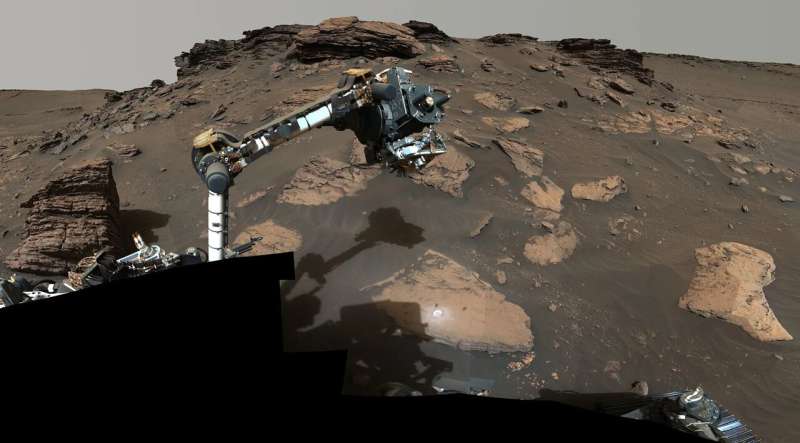This article has been reviewed according to Science X's editorial process and policies. Editors have highlighted the following attributes while ensuring the content's credibility:
fact-checked
trusted source
proofread
Team assessing SHERLOC instrument on NASA's Perseverance rover

Engineers are working to stabilize a dust cover on one of the science instrument's cameras.
Data and imagery from NASA's Perseverance Mars rover indicate one of two covers that keep dust from accumulating on the optics of the SHERLOC instrument remains partially open. In this position, the cover interferes with science data collection operations.
Mounted on the rover's robotic arm, SHERLOC (Scanning Habitable Environments with Raman & Luminescence for Organics and Chemicals) uses cameras, a spectrometer, and a laser to search for organic compounds and minerals that have been altered in watery environments and may be signs of past microbial life.
The mission determined on Jan. 6 that the cover was oriented in such a position that some of its operation modes could not successfully operate. An engineering team has been investigating to determine the root cause and possible solutions. Recently, the cover partially opened. To better understand the behavior of the cover's motor, the team has been sending commands to the instrument that alter the amount of power being fed to it.
With the cover in its current position, the instrument cannot use its laser on rock targets and cannot collect spectroscopy data. However, imaging microscopy can still be acquired with WATSON, a color camera on SHERLOC used for taking close-up images of rock grains and surface textures. WATSON (Wide Angle Topographic Sensor for Operations and eNgineering) operates through a different aperture.
SHERLOC is part of a seven-instrument suite on Perseverance. During the development of the mission, the team designed the instrument suite such that the rover could still achieve its science objectives should any single instrument fail, as there is some overlap among the capabilities of the instruments. Along with SHERLOC, PIXL (Planetary Instrument for X-ray Lithochemistry) and SuperCam also perform spectroscopy.
Currently making its way to explore an area nicknamed "Beehive Geyser," the rover marked its 1,000th Martian day, or sol, on the Red Planet on Dec. 12, 2023—more than 300 sols beyond its initial prime mission. Since the rover's landing on Feb. 18, 2021, SHERLOC has scanned and provided rich data on 34 rock targets, creating a total of 261 hyperspectral maps of those targets.
Featuring a radioisotope power system, Perseverance's design is based on the agency's Curiosity Mars rover, which is still going strong after more than 11 years (4,000 sols) on the Red Planet.
Provided by NASA





















